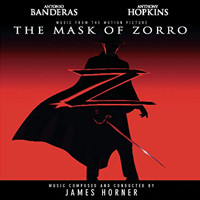- Composed by James Horner
- Sony / 75m
An unexpected smash hit, The Mask of Zorro was a thoroughly-entertaining old-fashioned adventure romp starring Anthony Hopkins and Antonio Banderas as older and younger versions of Zorro; Catherine Zeta-Jones was the former’s daughter and the eventual love interest of the latter. Martin Campbell was fresh from the success of Goldeneye and turned down the chance to do another Bond for this.
James Horner wanted to do something lighter after Titanic and this film brought his brightest and most instantly entertaining score in a while. It is brilliant from the first moment – the lengthy, barnstorming “The Plaza of Execution” begins with a striking guitar before the sound of flamenco dancers gradually builds for the film’s logos. It’s so striking and creative, and throughout the score Horner mixes that sound with other flamenco touches, his signature action/adventure sound and no shortage of romance.

The first cue also presents no fewer than three for Zorro stridently – the first is often used as an action theme later, the second (the one usually called “Zorro’s theme”) is quite romantic and uses as its launching pad the great Miklós Rózsa’s theme from El Cid, which Horner said was the greatest Spanish-influenced Hollywood film score, full of Latin passion and flair; and the third is a grand adventure theme. Passion and flair are also in evidence in the first half of “Elena and Esperanza”, in which the love theme is introduced – there are two distinct melodic sections, one often heard for solo guitar, the other for strings – both are swooningly gorgeous. The second half of the cue gets a lot darker for a while before coming to an epic conclusion with a full orchestral version of the first part of the love theme. Throughout the second half of the cue, Horner uses Kazu Matsui and his shakuhachi flute for colour – it may be clearly ethnically inappropriate but it certainly works.
“Ride” is a phenomenal piece of action music – opening with a clear tip of the hat to the Korngoldian style, it’s not long before the flamenco returns (guitars, hand claps and castanets) and the wonderfully swashbuckling adventure theme gets a grand airing for horn. It’s so much fun. The ubiquitous danger motif opens “Elena’s Truth” and Horner twists it into a dark version of the love theme.
Horner didn’t often do “funny music” but he does in “Fencing Lesson”, indulging in a bit of comic mickey-mousing with lots of flamenco touches. “Tornado in the Barracks” is another colourful and highly enjoyable action track, reprising the Zorro action theme alongside some wonderful Ravellian flair in its first half before using the main Zorro theme as the base for the second. “The Confession” is a beautiful standalone piece, a very gentle melody eventually leading to a particularly lilting solo guitar arrangement of Zorro’s theme.
Next comes a track called “Zorro’s Theme” which I assume was written for the album – it’s sad that it’s not a swashbuckling version of his actual themes but actually is much more focused on the love theme. There is a wonderful flourish midway through as the horns herald the arrival of the main Zorro theme, but it serves mainly as a bridge into the love theme again.
“Mine (Montero’s Vision)” is quite a dark cue with some militaristic snares, quite suspenseful; from then on we’re into extended action and adventure territory all the way to the end. “Stealing the Map” starts with a set of suspenseful variations on a number of the score’s themes (with a hint of Aliens at one point) before the flamenco foot and hand clapping gets ever more intense brassy accompaniment, alongside percussion, the shakuhachi and even some signature rumbling piano, exploding into Zorro’s theme. The 13-minute “Leave No Witnesses…” does more of the same, alternating moments of suspense (which at times recall Willow) with spectacular adventurous outbursts before the score comes to a glorious end in “Diego’s Goodbye”, opening with a gentle version of the B-section of the love theme before a lovely romantic set of variations on the A-section, then back to a soaring version of the whole thing (those horns!)
Not surprisingly, there’s a song to round things off – “My Heart Will Go On” was still very much in people’s minds at the time but for my money this score’s “I Want to Spend My Lifetime Loving You” is a much better song, perhaps Horner’s finest outside of animation. While the lyrics are as corny as anything, it’s a lovely romantic ballad based on the two parts of the love theme and performed with gusto by Marc Anthony and Tina Arena.
Horner tended to gravitate towards more earnest films in the aftermath of his Oscar win; The Mask of Zorro was unusual in that it allowed him to write a score big in scope but with tongue often firmly planted in cheek, at its heart a straightforward and classic action/adventure film score. He would only do that again once (for this film’s sequel, whose score is just as good). It’s one of the most fun scores he ever wrote.
Rating: *****
facebook.com/moviewave | twitter.com/MovieWaveDotNet | amazon.com












This page has three v. interesting interviews with Horner about this score:
http://jameshorner-filmmusic.com/words-james-horner-6-mask-zorro/
Fantastic review to one of my favorite Horner scores. And those interviews you linked to are really great! You can tell how seriously Horner took his music.